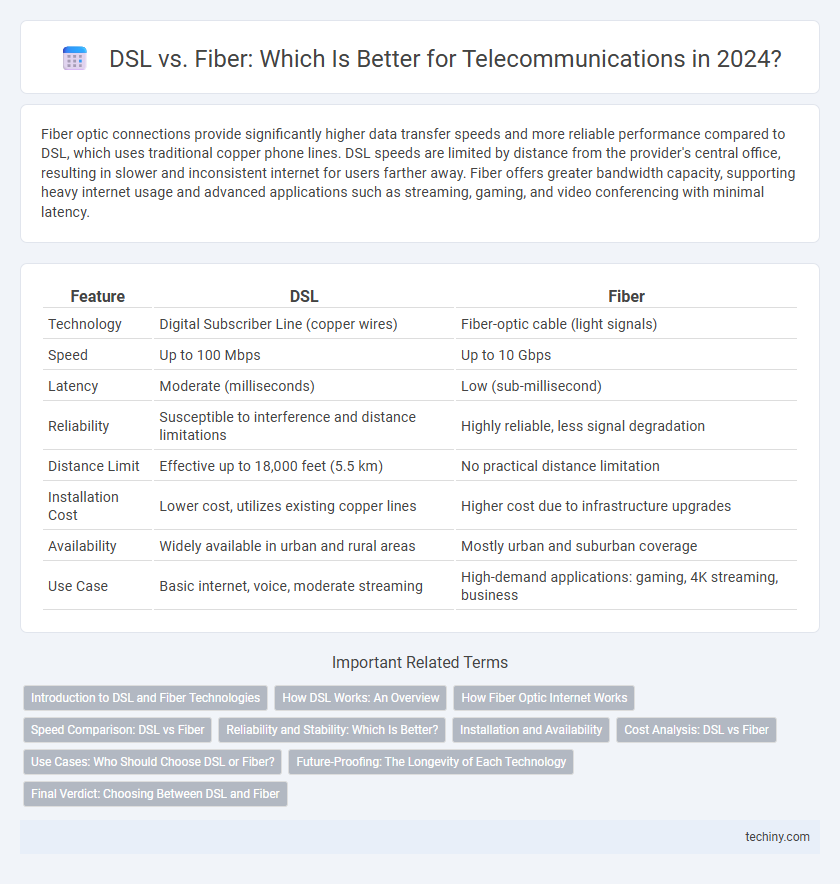Fiber optic connections provide significantly higher data transfer speeds and more reliable performance compared to DSL, which uses traditional copper phone lines. DSL speeds are limited by distance from the provider's central office, resulting in slower and inconsistent internet for users farther away. Fiber offers greater bandwidth capacity, supporting heavy internet usage and advanced applications such as streaming, gaming, and video conferencing with minimal latency.
Table of Comparison
| Feature | DSL | Fiber |
|---|---|---|
| Technology | Digital Subscriber Line (copper wires) | Fiber-optic cable (light signals) |
| Speed | Up to 100 Mbps | Up to 10 Gbps |
| Latency | Moderate (milliseconds) | Low (sub-millisecond) |
| Reliability | Susceptible to interference and distance limitations | Highly reliable, less signal degradation |
| Distance Limit | Effective up to 18,000 feet (5.5 km) | No practical distance limitation |
| Installation Cost | Lower cost, utilizes existing copper lines | Higher cost due to infrastructure upgrades |
| Availability | Widely available in urban and rural areas | Mostly urban and suburban coverage |
| Use Case | Basic internet, voice, moderate streaming | High-demand applications: gaming, 4K streaming, business |
Introduction to DSL and Fiber Technologies
DSL (Digital Subscriber Line) technology transmits data over existing copper telephone lines, offering broadband internet access with speeds typically ranging from 1 Mbps to 100 Mbps depending on the DSL variant. Fiber optic technology uses strands of glass or plastic fibers to transmit data as light signals, enabling ultra-high-speed internet connections exceeding 1 Gbps with low latency and minimal signal degradation over long distances. While DSL remains widely available due to existing infrastructure, fiber networks provide superior bandwidth and future-proof performance for modern telecommunications needs.
How DSL Works: An Overview
DSL (Digital Subscriber Line) transmits high-frequency data signals over existing copper telephone lines without interfering with voice services, utilizing frequencies above the voice band. The technology separates voice and data traffic through filters and splitters, enabling simultaneous telephone and internet use. DSL speeds depend on the distance from the service provider's central office, with maximum rates typically reaching up to 100 Mbps for VDSL variants but decreasing significantly over longer distances.
How Fiber Optic Internet Works
Fiber optic internet transmits data as pulses of light through thin strands of glass or plastic fibers, enabling high-speed and high-capacity connections over long distances with minimal signal loss. Unlike DSL, which uses electrical signals over copper telephone lines, fiber optics leverage the principles of total internal reflection to maintain signal integrity and deliver gigabit and multi-gigabit speeds. This technology supports enhanced bandwidth, lower latency, and greater reliability, making it ideal for modern telecommunications demands.
Speed Comparison: DSL vs Fiber
Fiber optic internet delivers significantly faster speeds than DSL, with average download rates exceeding 1 Gbps compared to DSL's typical maximum of 100 Mbps. This speed disparity arises from fiber's use of light signals transmitted through glass fibers, enabling higher bandwidth and lower latency. For bandwidth-intensive applications like 4K streaming, gaming, and large file transfers, fiber offers a superior user experience over traditional DSL technology.
Reliability and Stability: Which Is Better?
Fiber optic internet offers superior reliability and stability compared to DSL due to its immunity to electromagnetic interference and signal degradation over long distances. DSL technology relies on traditional copper telephone lines, which are more susceptible to interference and signal loss, especially during adverse weather conditions. Fiber's advanced infrastructure ensures consistent high-speed connectivity, making it the preferred choice for mission-critical applications and stable network performance.
Installation and Availability
Fiber optic installation typically requires new cabling and infrastructure upgrades, making it more complex and time-consuming than DSL, which utilizes existing telephone lines for easier deployment. Fiber availability is often limited to urban and suburban areas due to higher installation costs, whereas DSL is widely accessible across rural and remote locations because of established copper networks. The differing installation requirements directly impact service reach, with fiber offering superior speed but more restricted availability compared to the extensive, but slower, DSL coverage.
Cost Analysis: DSL vs Fiber
DSL technology generally offers lower initial installation fees and equipment costs compared to fiber optics, making it a more affordable option for budget-conscious consumers and small businesses. Fiber optic networks typically require higher upfront investments due to expensive infrastructure deployment, but they provide significantly greater bandwidth capacity and future scalability. Over the long term, fiber can offer better value through reduced maintenance costs and higher performance, justifying the initial cost for high-demand users and enterprises.
Use Cases: Who Should Choose DSL or Fiber?
Fiber optic internet suits businesses and households requiring ultra-fast speeds, low latency for streaming, gaming, or cloud computing. DSL remains a cost-effective choice for rural or suburban users with moderate internet usage, such as browsing and emailing. Enterprises with high bandwidth demands and future-proof connectivity benefits significantly from fiber deployment.
Future-Proofing: The Longevity of Each Technology
Fiber optic technology offers superior future-proofing compared to DSL, with significantly higher bandwidth capacities supporting speeds up to 10 Gbps and beyond, ensuring scalability for emerging applications and services. DSL, relying on copper telephone lines, faces inherent limitations in speed and distance, making it less adaptable to the increasing demands of 5G integration, IoT expansion, and high-definition streaming. Telecom providers are rapidly upgrading infrastructure to fiber networks, driven by its longevity and ability to meet future data consumption trends.
Final Verdict: Choosing Between DSL and Fiber
Fiber optic internet offers significantly higher speeds, lower latency, and greater reliability compared to DSL, making it the preferred choice for bandwidth-intensive applications and future-proof connectivity. DSL remains a cost-effective option for users in areas lacking fiber infrastructure or with moderate internet usage demands. The final decision hinges on availability, budget, and specific performance needs, with fiber recommended where accessible.
DSL vs Fiber Infographic

 techiny.com
techiny.com